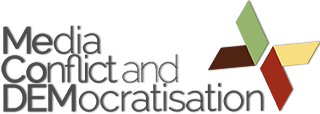MeCoDEMvis: images of media, conflict and democratisation
Giorgia Aiello, Katy Parry and Tim Wege
Introduction – This 15-minute film was borne out of a shared understanding among MeCoDEM members, that in times of conflict and democratisation visual images become powerful vehicles of testimony and denunciation but also creativity and celebration. To highlight the importance of the stories, narratives, frames and memories that circulate during times of transition, we decided to focus on some of the ways in which imagery may give voice or visibility to particular actors and constituencies in relation to protest, election campaigns, commemorations, street art and other forms of political expression (see Working Paper on Culture and Democratisation). In addition to working on a series of publications on the visual and more broadly cultural dimensions of the four country teams’ case studies, we wanted to capture the project’s key themes through some of the very images that we wish to interrogate. Dr Giorgia Aiello and Dr Katy Parry worked with each country team and with South African film producer Tim Wege to craft a cinematic narrative of research from each country through a set of still images sourced from a variety of image-makers, including professional photographers, amateurs, and photojournalists. The majority of these images were acquired from creative commons sources or were licensed from photographers like Vladimir Krzalic (Serbia) and Armand Hough (South Africa). What emerges from the film is not only the importance of symbolic production and visual representation in politics, but also a complex web of themes that move beyond the project’s focus on processes of democratisation. Some of the film’s themes include identity, citizenship, nationhood, participation, migration, humanitarianism, inequality, hope and imagination, among others– thus showing the complexity of MeCoDEM’s findings over three years’ worth of research, across four different countries.
Generation 1994: envisioning democracy in Serbia
Aleksandra Krstić and students at the Department of Journalism and Communication, Faculty of Political Sciences, University of Belgrade
Introduction – Fourth year students at the Department of Journalism and Communication in the Faculty of Political Sciences, University of Belgrade, prepared this video in connection with the MeCoDEM project. The video was presented during the final Consortium Meeting in Cape Town in December 2016. The students were born in 1994 under the authoritarian regime of Slobodan Milošević. They spent their early childhood in times of crisis: the Balkan civil wars, street protests and demonstrations against the authoritarian regime. They entered the education system in 2001, after Milošević had been removed from power and as the transition to democracy began. They are now in the final year of Journalism Studies and a number of them attended the investigative TV journalism course I taught during the winter semester 2016/2017. After I (Aleksandra Krstić) read the outline of MeCoDEMVis, a fantastic part of MeCoDEM project, I wanted to see how students born in 1994 visually perceive transition, democracy, human rights, citizenship and other topics related to MeCoDEM. We had never discussed the visual aspects of these themes before. Students had only referred to some visual aspects of democracy in their practical work at the Faculty, as part of the regular TV programme our Department produces, but these themes were only touched upon and incorporated within other, broader topics of their interest.
Therefore, as soon as the winter semester began in early October 2016 and the MeCoDEMVis outline for selecting images that would tell the broader story of conflict cases within MeCoDEM was finalised, students were asked to write a script about how they envision Serbia’s authoritarian past and the state of democracy. At first their scripts were long and abstract, mostly expressing metaphors of democracy, rather than true representations of the way they perceive various aspects of democracy, that is, what they associate the past or democracy with or what could actually be filmed etc. After several weeks of discussion, visiting places in the city, guiding students through in-depth interpretations of the Serbian cases examined within MeCoDEM and writing one final script together, we decided to show several short stories embedded in one video. Besides giving a visual presentation of their thoughts on transition, each author was given the opportunity to prepare a stand-up or dialogue, saying a couple of sentences into the camera. The hardest part was to make the video understandable for foreign audiences, to make it clear for people who know very little or nothing at all about Serbia’s past or present.
The video represents the students’ relationship to the past, their thoughts on the advantages and disadvantages of transition, as well as images of the urban sites they see as monuments of the past. The video shows students’ commitment to team work and the strength of their desire to become journalists in a democratic country. The images were filmed by students and professionally edited at the Faculty’s Media Centre.
